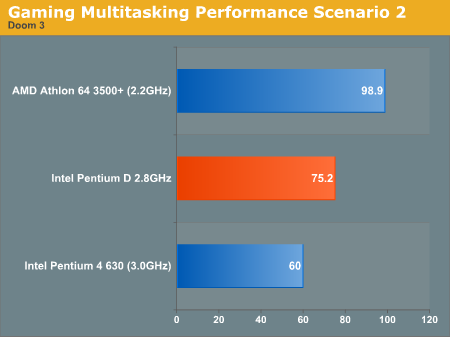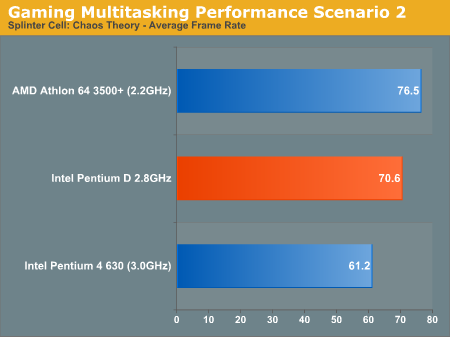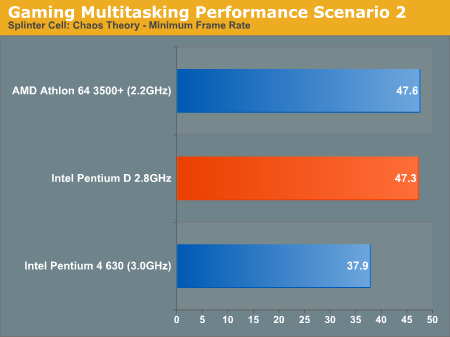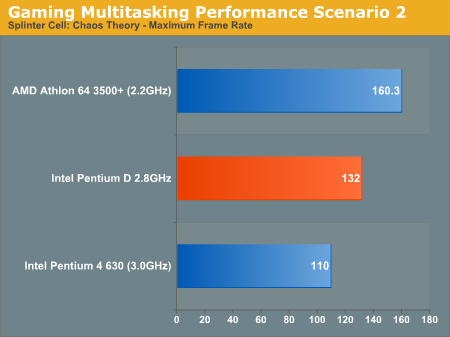Intel Dual Core Performance Preview Part II: A Deeper Look
by Anand Lal Shimpi on April 6, 2005 12:23 PM EST- Posted in
- CPUs
Gaming Multitasking Scenario 2: DVD Shrink
For our next test, we wanted to do something a little less strenuous, so we only ran one background task: DVD Shrink. We left DVD Shrink at its default low priority and went ahead with our benchmarks:

Thanks to DVD Shrink behaving and running with a low priority, our gameplay was largely unaffected on the Athlon 64. The performance dropped less than 3% in Doom 3.
What's very interesting, however, is that the Pentium 4 630 takes a huge performance hit with DVD Shrink running in the background. Despite being set to a low priority, since Hyper Threading allows both the DVD Shrink thread and Doom 3 thread to execute concurrently, they both contend for the same microprocessor execution resources. This happens to be one case where Hyper Threading is actually very bad for performance, as the OS has no idea that its scheduling is actually hurting the CPU's performance severely.



The performance gap between the Pentium D and the Athlon 64 actually closes quite a bit under Splinter Cell. The minimum frame rates are now identical, although the maximum frame rates are clearly higher on the AMD system.
Once again, HT has a negative impact in this case on the Pentium 4 630.
Just for kicks, we decided to turn off DVD Shrink's low priority setting to see what impact that would have on performance. The low priority mode of DVD Shrink basically makes it transparent to gaming. Unchecking this option definitely changes things, it wouldn't even start on the Athlon 64 system.
It eventually ran on the Pentium D system after waiting several minutes for it to start, and even then, performance wasn't acceptable. It just goes to show you that dual core isn't Superman; it does have its limits.










106 Comments
View All Comments
justly - Thursday, April 7, 2005 - link
#84 What do you consider "very soon"?
The following was quoted from "part 1".
"Make no mistake, Intel isn't officially releasing their dual core desktop processors today; this is merely a preview. Intel's dual core line is still on track to be released sometime in the April - June timeframe."
IF it where to be released in April then there should have been more reviews (sorry, previews).
IF it comes out in May then there is no need to do a preview this early (except to gain marketing hype).
IF it comes out in June then a "preview" this early should have contained technical information about the chip with a "review" containing benchmarks at a later date closer to its release date.
jojo4u - Thursday, April 7, 2005 - link
Was Cool'n'Quiet enabled at the power draw test?fitten - Thursday, April 7, 2005 - link
#81, Intel publicly stated that implementing HT on the P4 was about a 5% increase in logic/area on the chip. While it may be "ugly" and such, 5% certainly isn't that much of area when you consider how much area other functionality takes up.#82, I haven't seen anyone announce duel core products. Dual core products, however, should be out very soon from Intel (and are [p]reviewed in the article this discussion is attached) for example). ;)
Kagjes - Thursday, April 7, 2005 - link
I must say i really can't relate to any of these multitasking scenorios. Well, except the teamspeak-gaming part.What would be most interesting for me is dual-core, dual monitor setup. That would ROCK, and i'm really suprised noone remembered that. For instance, playing a divx on 1 monitor while gaming on other. Or watching TV on 1 while gaming on other (i do that a lot, if the football match is boring). These tasks are pretty much repeatable and can be measured. I was thinking about getting another monitor for these kind of purposes, but i'm not sure on how would my comp react to that kind of stress.
justly - Thursday, April 7, 2005 - link
My personal thoughts about publishing an article on a duel core that is not yet availabile, nor will be for awhile, is that it is strictly marketing hype similar to what happened with the 1.13 GHz P3 or any other product that we the consumer have to wait for.The idea that duel core would have a benifit in multitasking or multithreaded apps could have easily been demonstrated on a multiprocessor system using Opterons or Xeons. So now we get a review full of new (wow factor) benchmarks describing the new found benifit of having two processors working together.
I have no real problem with "preview" style articles, but having a plethora of benchmaks in a "preview" is pointless unless the goal is to advertise (hype) a product. The only people I see having any use for this "perview" are the ones that desperately want proof that their manufacturer of choice (this time being Intel) is superior, or those people who are so fickle that they will support the newest thing on the block no matter if it is needed, affordable or even the best option at the time it becomes available.
Quanticles - Thursday, April 7, 2005 - link
Ive heard that HT is very ugly to impliment, you have to tear everything up. I'm not sure HT is very useful when you have dual core anyway.fitten - Thursday, April 7, 2005 - link
#47, if HT is simply a "bandaid", then why is AMD the only major CPU vendor not using it? IBM uses it heavily in their Power5, Sun is making their next CPUs (Niagra) very highly SMT (same thing as HT). Arguably, both of those architectures have much more shallow pipelines than the P4, yet see reason to provide SMT. AMD is the only holdout.dougSF30 - Thursday, April 7, 2005 - link
Make that 2.4GHz in Q3 (not Q4) for the DC Opti 2.4GHz.dougSF30 - Thursday, April 7, 2005 - link
DC A64 samples are at 2.4GHz, not 2.2GHz.DC Opteron is supposedly launching at up to 2.2GHz in a couple weeks, and will be available at 2.4GHz in Q4.
DC Opteron fits in 95W TDP, DC A64 gets a 110W TDP.
Both are apparently 2 x 1MB L2, per the Italian site that put the CeBIT-timed article about the DC A64 sample.
dparish - Thursday, April 7, 2005 - link
Great article. I am confused by one piece:From page 8:
Seagate Barracuda 7200.7 NCQ - 25.2 minutes
Seagate Barracuda 7200.7 no NCQ - 33.6 minutes
Western Digital Raptor WD740 - 30.9 minutes
I'm shocked that the WD740 is slower. Isn't this the NCQ enabled 10,000 rpm drive? I would have expected this to beat out the 7200.7 NCQ seagate. Any reason why the WD740 would be slower?
Another point / comment:
Is it possible that DVD Shrink is slower on the AMD's because it has not been compiled / optimized for the AMD? Would this be any different on the 64 bit version of XP if DVD Shrink was compiled for 64 bit? Of course this may be moot as DVD Shrink is not longer being developed by the author.
-Dave